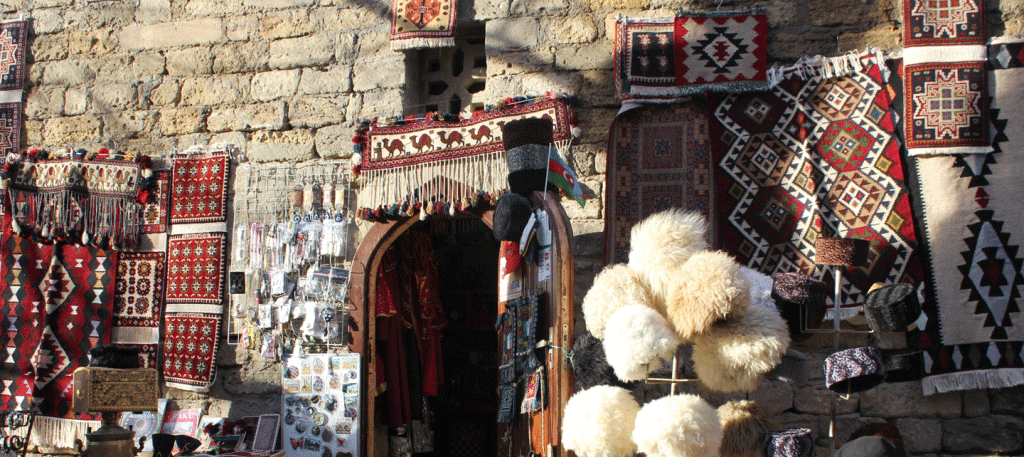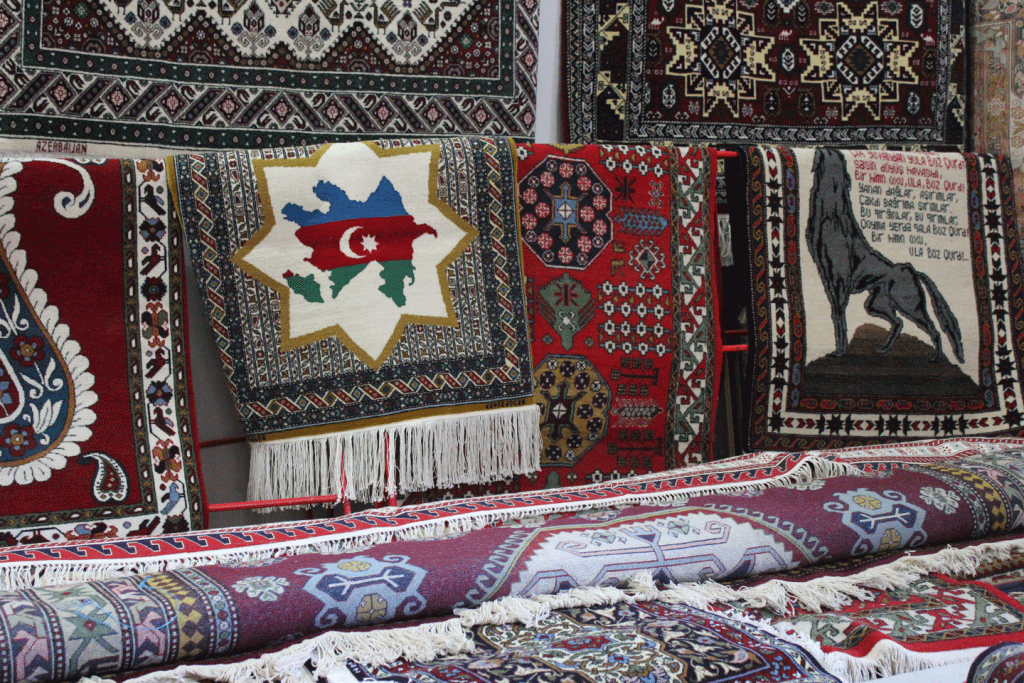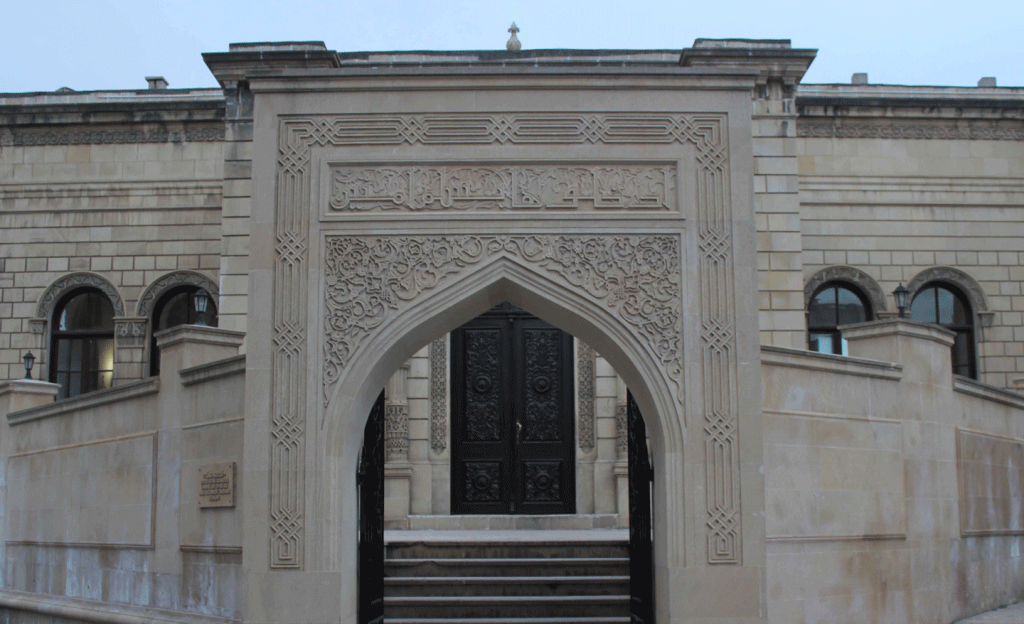,,

MEDIEVAL HISTORY
Silk trade route
In late medieval times Azerbaijan became the seat of varying Empires. Geographically and culturally, it has always been a bridge uniting east and west and between Asia and Europe. As a result, Azerbaijan has incorporated the many traditions of the peoples that surround their country. One of the reason for this is that the caravan routes of the Silk Road have always crossed Azerbaijan. Thereby it served as the gateway between mysterious faraway China and rich Europe.
Development of the Silk Route
In the 1st – 2nd centuries BC the busiest route started from China and India. It crossed Central Asia, the Caspian Sea and went across the territory of Azerbaijan. There it split into two roads. The first led upstream the Kura towards Colchis and Iberia, the second went along the western coast of the Caspian Sea.
Azerbaijan was known as the safest of the entire Silk Road and therefore attracted many merchants. Another key attraction was the fact that the most of the way allowed transportation by water, which was the cheapest method. As such, that section was durable, stable and vibrant. It was one of the major destinations of the Silk Road in antiquity.
Influence of the Silk Route on Azerbaijan Cities
It was along these split branches of the Silk Road that the numerous individual cities of Azerbaijan were founded. During early Middle Ages Azerbaijan still remained at the important centre of the route. Barda, which became the capital of Azerbaijan in the 5th century, was considered the world’s greatest trading centre on one of branches of the Silk Road. Moreover, until the 10th century was one of the greatest centres of crafts of the entire Middle East.
Talented craftsmen offered foreign merchants a great variety of useful goods – graceful jewellery, wind and string musical instruments, expensive weaponry, magnificent carpets and of ocourse, local types of silk. The merchants took to Europe; oil, jewellery, salt, mercury, alum, wool, flax, cotton, mineral dyes, medicines and many other things from Barda. Copper items were especially famous: kitchen ware, trays, candlesticks, astronomical devices.
Many centuries after, when Islam was adopted as the official religion of the country, medieval Azerbaijan continued to maintain trade relations and exchanged its cultural values with many countries. In the 14th – 18th centuries the role of Azerbaijan cities located on the Silk Road increased even more. This was due to the development of the Volga-Caspian Sea waterway used by Russian and English merchants.
During that period many of its cities became the transportation centres with warehouses for goods from Orient and Europe. It was there that the merchants from Russia, Europe, Turkey, Central Asia and Far East gathered. Sites to accommodate the trade caravans were built in all major cities. For the most part, local governors were paid lot of money to issue permits to build small monasteries, prayer and guest houses near where caravans would pass.
Ottoman Empire
Wars with the Sunni Ottoman Empire, the arch rivals of the Safavids, the current rulers, continued during the reign of Shah Tahmasp. Briefly, the important Safavid cities of Shamakha, Ganja and Baku were occupied by Ottomans in the 1580s.
The reign of Shah Abbas I the Great was represented as a high point of development of the state and he was able to repel the Ottomans and re-capture the entire Caucasus, in 1603.

Carpets
Azerbaijan has always been known as an ancient centre of carpet weaving. The Azerbaijani rug is a traditional handmade textile of various sizes, with dense texture and a pile or pile-less surface; whose patterns are representative of each of Azerbaijan’s many carpet-making regions. Traditionally, since ancient times the carpets were used in Azerbaijan to cover floors, decorate interior walls, sofas, chairs, beds and tables. Read more about the different types.
Carpet making is a family tradition transferred orally and through practice, with carpet making and rug making almost exclusively a women’s occupation. In the past every young girl had to learn the art of weaving carpets, and the carpets she wove became a part of her dowry. In the case of a newly married son, it was his mother who wove a large rug for his new household.
Starting a new carpet meant a feast, but the completion of a rug meant an even greater celebration for the family. In the old days finished carpets were laid out in front of the house so that passers-by with the weight of their feet could make them even tighter than they had already been knotted. For the traditional process of carpet and rug making, men sheared the sheep for the wool in the spring and autumn, while women collected dyestuffs and spin and dye yarn in the spring, summer and autumn.
Periods of Carpet Weaving
An archaeological dig on the territory of Azerbaijan testifies to carpet-weaving that date as far back as to the 2nd millennium BC. Some excavations discovered carpet weaving tools which date back to the 4th-3rd millennium BC. It was highly valued by the heads of states, and the gifted weavers were glorified by the greatest poets. The carpet history is assumed to be divided into the following four main periods:
- I period – the early stage of the carpet development. The carpet ware is very simple, without any motifs and patterns.
- II period – introduction of the kilim weaving practice by the intricate threading technique.
- III period – The period of simple and complex whipping techniques.
- IV period – introduction of the knotted pile weaving. Both from the technical and artistic standpoints this stage can be considered the pinnacle of the carpet making.
The mutual exchange of influences through all the different states and areas of Azerbaijan were reflected in carpet making as well. Throughout Azerbaijan appeared numerous carpet production centres each featuring its own specific style and school.
The rise of the carpet art on the territory of Azerbaijan was undoubtedly related to a number of factors. Among them the geographical location of this land, at the joint of the East and the West and the borderline between Asia and Europe. Namely, it is the historical meeting point between the Islamic and Christian cultures.
The Seven Schools of Carpet Weaving
Quba School of carpet weaving
The Quba School covers up to 35 pattern compositions of the carpets. Quba is a historical region hosting a plenitude of various tribes. Even now the region is populated by ethnic groups that speak different languages. The Quba carpets are remarkable for a wide variety of designs, which may differ even from village to village. The ornamental pattern is characterized by geometrical and vegetal motifs, most of them stylized. On the face of it, the ornamental pattern in the Quba carpet group may appear to be too mixed and varied. However, on closer examination it becomes evident that all ornaments in the composition strictly follow a common design.
Shirvan School of carpet weaving
The Shirvan School is particularly famous for its carpets. Shirvan is one of the most ancient historical regions of Azerbaijan. Carpet making of different types is a widespread craft with both settled and nomadic natives. The Shirvan carpets are characterized by an intricate design, which depicts numerous artefacts of everyday life, birds and people.
Ganja-Kazakh school of carpet weaving
The carpets of this school are notable for peculiarity of their compositions and ornamental patterns. The Ganja carpets include a relatively small number of carpet compositions, all in all between 8 and 20 patterns. The Kazakh carpets cover about 16 compositions with various patterns. The Kazakh carpets have a geometrical ornamental pattern; the composition is not very complex with a focus on a schematic presentation of the geometrical patterns, plants and animals. The ornamental decor of the Ganja carpets is rich and diverse, with a focus on geometrical motifs as well as schematic presentation of plants and animals.
Baku school of carpet weaving
The Baku school of carpet weaving are marked for their increased softness of the material and intense colours, as well as excellent artistic taste and exquisite decoration. This school has about 10 compositions. The historical sources and inscriptions on the carpets testify to the fact that carpet making was widely spread in these villages and carpet-ware was exported outside the country. The carpet composition often includes medallions. They are filled by various motifs, most often by stylised images of plants, which lost their resemblance to the original object after they had been geometrised.
Karabakh School of carpet weaving
The Karabakh carpets amount to 33 compositions. Due to the specifics of the local sheep wool the Karabakh carpets are characterised by thick pile, high and fluffy. These carpets are marked for their vivid and joyous colours. They are divided into four groups: without medallions, with medallions, Namazlyk and Subject carpet.
In November 2010 the Azerbaijani carpet was proclaimed a Masterpiece of Intangible Heritage by UNESCO. The organisation established a list of Intangible Cultural Heritage with the aim of ensuring the better protection of important intangible cultural heritages worldwide and the awareness of their significance. The program aims to draw attention to the importance of safeguarding heritage, which UNESCO has identified as an essential component and as a repository of cultural diversity and of creative expression

Feudal era
The Seliuq period of Azerbaijan’s history was possibly even more pivotal than the Arab conquest as it helped shape the ethno-linguistic nationality of the modern Azerbaijani Turks. After the decline of the Islamic Abbasid Caliphate, the territory of Azerbaijan was under the sway of numerous dynasties. Most of them, such as Salarids, Sajids were of Turkic origin, while the Rawadids were of Arab origin.
However at the beginning of the 11th century, the territory was gradually seized by waves of Oghuz Turkic tribes emanating from Central Asia. The first of these Turkic dynasties took over part of Azerbaijan by 1030. They were followed by the Seljuqs who conquered all of Iran and the Caucasus and pressed on to Iraq where they overthrew Baghdad in 1055.
The Seljuqs became the main rulers of a vast empire that included Iran and Azerbaijan until the end of the 12th century. During the Seljuq period, they helped introduce numerous educational and bureaucratic reforms. Under their rule from the end of 12th to early 13th centuries, Azerbaijan emerged as an important cultural centre of the Turkic people. Palaces such as the Shirvanshahs hosted distinguished people of the time, many of whom were outstanding Muslim artisans and scientists.
Under the Seljuqs, great progress was achieved in different sciences and philosophy by Azerbaijanis like Bahmanvar and Khatib Tabrizi. Azerbaijanian poets such as Nizami Ganjavi and Khaqani Shirvani represented the peak of medieval Azerbaijani literature.
In addition, the region experienced a boom in construction. This unique 12th century architecture of the Seljuq period is still well preserved. Typical representations which remain, include fortress walls, mosques, schools, mausoleums, and bridges of Baku, Ganja and Absheron. In 1225, the Mongol invasion put an end to their rule.
Rulers and the Shirvanshahs
The Shirvanshahs (also spelled Shīrwān Shāh or Sharwān Shāh) was the title of a medieval Islamic dynasty of Turkic origin. They established a native Azerbaijan state and were rulers of Shirvan, a historical region in present-day Azerbaijan. The Shirvanshahs established the longest Islamic dynasty in the Islamic world. They were located in modern Azerbaijan Republic, from the mid-9th century to the early 16th century. Shivan was founded in 799 by Yazid b. Mazyad al-Shaybani and their final ruler was Abu Bakr Mirza. The Shirvansha state dissolved completely in 1607.
Legacy of the Shirvanshahs
The role of the Shirvanshah state was important in the national development of Azerbaijan. The Shirvanshahs had a great degree of independence and power as local rulers and leaders from 861 until 1539.
There are two key periods of Shirvan ruling Azerbaijan. First in the 12th century, under the Sultans Manuchehr and Axsitan who built the city of Baku. The second was in the 15th century, under the Derbendid dynasty. Between the 13th and 14th centuries, the Shirvanshahs remained feudal lords in both the Mongol and Timurid empires.
The Shirvanshahs Khalilullah I and Farrukh Yassar presided over a highly stable period in the history of the dynasty. The “Shirvanshah palace” in Baku (that was also a burial site of the dynasty) was built during the reign of these two rulers in the mid-15th century. The Shirvanshah dynasty was also known for their patronage of Azerbaijanian poetry supporting many writers and poets during their time. In 1462 the leader of Safavid Sufi’s (another dynasty within the Persian Empire) was killed in battle against Shirvanishans, an event that shaped subsequent Safavid retaliation.
Shirvanshahs built many defensive castles across all of Shirvan to resist foreign invasions. From the walled city of Baku with its Maiden Tower and many medieval castles in Absheron to impregnable strongholds in the mountains of Shirvan and Shaki. There are many noteworthy examples of medieval military architecture from this period.
Rise and Fall of the Safavids
However, Shirvan was greatly devastated by Mongol invasion in 1235. Ultimately, it was not able to fully recover over the next century. By 1500, significantly weakened Shirvan suffered the onslaught of avenging Safavids. The Shirvan state managed to hang on until 1538, when, weakened by internal conflict it fell to Safavid control.
After the collapse of the Safavid empire, Nadir Shah from the Afshar tribe of Oghuz Turks came into power and took control over Iran and other adjacent territories. After his assassination in 1747, the Empire disintegrated. Agha Muhammad Khan from the Turkic tribe, Qajar, assembled a force of some 60,000 cavalry and infantry. He set off for Azerbaijan with an intention to reconquer all territories lost to the Ottomans and Russians.
Architecture
The Palace of the Shirvanshahs (or Shirvanshahs’ Palace is the biggest monument of the Shirvan-Absheron branch of architecture and is situated in the Inner City of Baku. The site contains the main building of the palace known as the ‘Divanhane’ and also the burial-vaults, the ‘Shah’s Mosque’ with a minaret, a mausoleum, a portal in the east – ‘Murad’s Gate’, a reservoir and the remnants of the bath-house.
In the 15th century the Shirvanshah dynasty, transferred the state capital to Baku following and began construction of the “palace”. The building is believed to be a memorial built around the sacred place of worship and family tomb. The wells inside the grounds of the “palace” were considered to have healing qualities until recent times, as was the hill where the palace was built. After the Safavid conquest of Baku in 1501 the “palace” fell into ruin.
The Bayil fortress
The fortifications in Bayil Bay, off Baku, are the remains of some of Shirvan’s most impressive medieval architecture. In historical literature the fortress is given called names such as the temple of fire worshippers, the underwater city and Bayil Rocks. Its historical importance is strengthened by the carved stones – inscriptions that are unrivalled in medieval Near Eastern decorative design. The stones bear images of living creatures; the first time they had been discovered on Muslim monuments. This monument was constructed with the Shirvanshah state at its most prosperous in the early 13th century.
It was built on top of a hill with an irregular rectangle in shape and was surrounded by rampart walls with towers at 15 intervals. There was a frieze around the upper part of the wall with inscriptions in Arabic script. The walls were built from hewn Absheron limestone and a cement-like mortar. Many of the towers were round and hollow inside while others were solid, a little smaller and semi-circular. From a distance, the fortress resembled a small rock island overlooking the sea. Despite its glory, it was swallowed up by the Caspian Sea within a century.
In more recent times the fort has been the subject of several archaeological investigations. Discovered 1938 were research 2 stone plates and, later, 35 inscribed stone slabs. In the 1930s and 1940s, 215 inscribed slabs were found as a result and 5 of the carvings included a date – 632 AH (1234-35 AD).
Icherisheher ‘The Old City
It is widely accepted that Icherisheher or ‘Old City’ of Baku dates at least to the 12th century, with some contending that early stages of construction go as far back as the 7th century. During the medieval period of Baku key monuments such as the Synyg Gala Minaret (11th century), the fortress walls and towers (11th–12th centuries), the Maiden Tower, the Multani Caravanserai and Hajji Gayyib bathhouse (15th century), the Palace of the Shirvanshahs (15th-16th centuries) and the Bukhara Caravanserai and Gasimbey bathhouse (16th century) were built.
By 1806, when Baku was occupied by the Russian Empire during the Russo-Persian War there were 500 households and 707 shops, and a population of 7,000 within the walls. Between 1807 and 1811 the city walls were repaired and the fortifications extended. The city had two gates: the Salyan Gates and the Shemakha Gates. The city was protected by dozens of cannons set on the walls.
It was during this period that Baku started to expand beyond the city walls, and new neighbourhoods emerged. Thus the terms Inner City and Outer City came into use. The Inner City was the main part. Hence, those who lived in the Inner City were considered natives of Baku. They were in close proximity to everything: the bazaar, craftsmen’s workshops and mosques. There was even a church there, as well as a military barracks built during the Russian occupation.
However, with the arrival of Russians the traditional architectural look of the Old City changed. Many European buildings were constructed during the 19th century and early 20th century, using styles such as Baroque and Gothic which are still present today.

